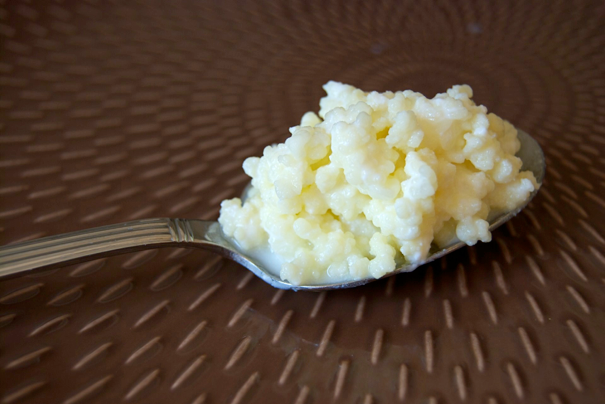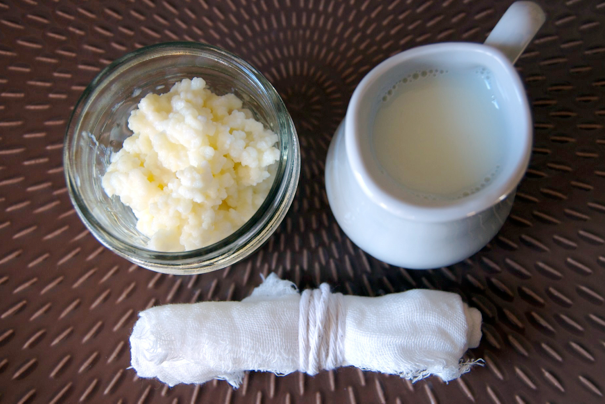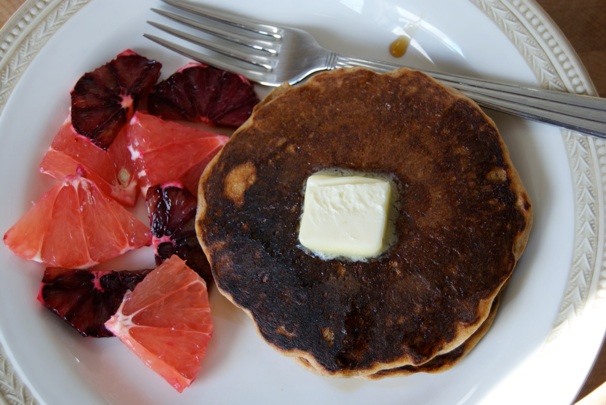
I’ve been a little hard on kefir. As a kid I thought it was something only “health food nuts” would buy it at the co-op along with wheat grass juice and granola. Our neighbors, who lived off the grid back in the 1970s, made kefir with milk from their goats. Goat’s milk I could almost handle as a kid, but fermented goat’s milk? No way. I’ve been rather bias against kefir ever since.
Fast forward 25 years later. I shop at the co-op. I make my own cheese, buttermilk, yogurt, pickles, sauerkraut, sourdough – you name it. I would love to have a backyard full of goats, chickens and honey bees. (I can get chickens and bees in Minneapolis, if my neighbors let me.) My friend Christopher ordered some kefir grains from The Kefir Lady online and made it while I was in the midst of writing my Greek Yogurt blog post. He gave me some grains and at first I did not care for the sour, yeasty tasting milk. Maybe I could make smoothies out of it, but that was about it. Then one morning I was gearing up to make pancakes and realized that I was out of buttermilk. Drat. My daughter and I love pancakes, making them 2 or 3 times a week. Could I use kefir in my pancakes? I didn’t see why not.
The results were fantastic. Because of the yeast component in kefir, the pancakes tasted like a cross between buttermilk and yeasted pancakes. I make my pancakes with 100% whole wheat flour, which can lead to heavy, flat pancakes. Buttermilk and baking soda prop them up a bit, but the kefir made them rise even higher than just buttermilk. And the unexpected bonus? The batter was still leavened the next day after sitting in the fridge, because the yeast in the kefir stayed active. Eureka! Below are the steps to make kefir, plus an easy recipe for pancakes.
Kefir is a “probiotic fermented milk drink,” which, according to Wikipedia, originated in the mountainous region between the Black and Caspian Seas in southern Russia. Made with kefir “grains,” the grains consist of a “symbiotic matrix” of yeasts and live bacteria, along with sugars and protein. They look like little cauliflower buds. When the grains are introduced to milk, they ferment the milk, causing it to effervesce, which is why they call kefir “milk champagne.” Get your kefir grains from a friend or an online source. There are also some kefir inoculates, but I’ve heard they don’t keep strength very long after several uses. Real grains will last forever if well cared for.

By Tammy Kimbler
Ingredients:
live kefir grains (a tablespoon or more)
1 quart milk
cheese cloth or dish towel
clean 1/2 pint jar
clean quart jar
Instructions:
Take your live kefir grains and place them in a clean 1/2 pint glass jar or non-reactive container. Cover with milk, leaving at least a 1/2 inch head space at the top, since sometimes the mixture expands from the bubbles. Cover the jar with a clean piece of cloth and tie with a string or rubber band. The kefir will release gases, so don’t seal it up to tight. Let the mixture stand 24 hours on the counter top.
The next day, check your small batch of kefir. The mixture should be thickened and may have separated into a raft of grains and curds with whey beneath. This is a good thing. Smell it. It should smell sweet, sour and yeasty, like milky fresh bread from the oven. If not much has happened, let it sit on the counter one more night and check it again. If it still hasn’t thickened or smells bad, you might have dead grains. Get some fresh ones and try it again. If all is well, proceed to step 2.
Take the whole small batch and put it in a clean glass quart jar. Top with more milk and stir well, this time leaving at least an inch of head space. Cover with cheese cloth and leave out over night. The next day, stir the kefir, then give it a taste. Some folks like a very mild kefir milk, others like it very sour and yeasty. Since I use mine mostly for baking, I like the strong kind. Leave it out another day or so for a stronger batch. Timing will also depend on how active your grains are, and how many you have. Mine are so active now that one night is enough to make a strong batch. If you like how it tastes, proceed to step 3.
Strain the kefir milk through a mesh strainer to filter out the kefir grains. It’s OK if curds are still clinging to the grains. Top the strained milk with a 2 piece canning lid (these can burp if gas builds up) and put it in the refrigerator where it will last several weeks. Don’t be surprised if it’s quite bubbly when you use or drink it. Transfer the grains to another 1/2 pint jar, and recover with milk. If you don’t intend to make more kefir, you can cover it and put it in the refrigerator. It will slow down the bacterial action, but the grains should last a couple of weeks before you need to revive them on the countertop, then it’s back to step one.
By Tammy Kimbler
Ingredients:
1 cup whole wheat flour
1 tsp baking powder
1/2 tsp baking soda
1/4 tsp salt
2 tsp sugar
1 large egg
1 tbs melted butter or oil
1 cup kefir milk
Instructions:
Combine the dry ingredients, then mix in the wet. The batter will bubble quite a bit. Cook on a medium griddle or cast iron pan for best results. You can also substitute 1/4 cup of flour for other whole grains like corn meal, buckwheat, teff, amaranth or the like. Teff and corn meal are particularly wonderful. My 5 year old daughter prefers to eat these with a few chocolate chips thrown in. I like maple syrup, myself. Leftover batter stores beautifully in the fridge for use again the next day.



